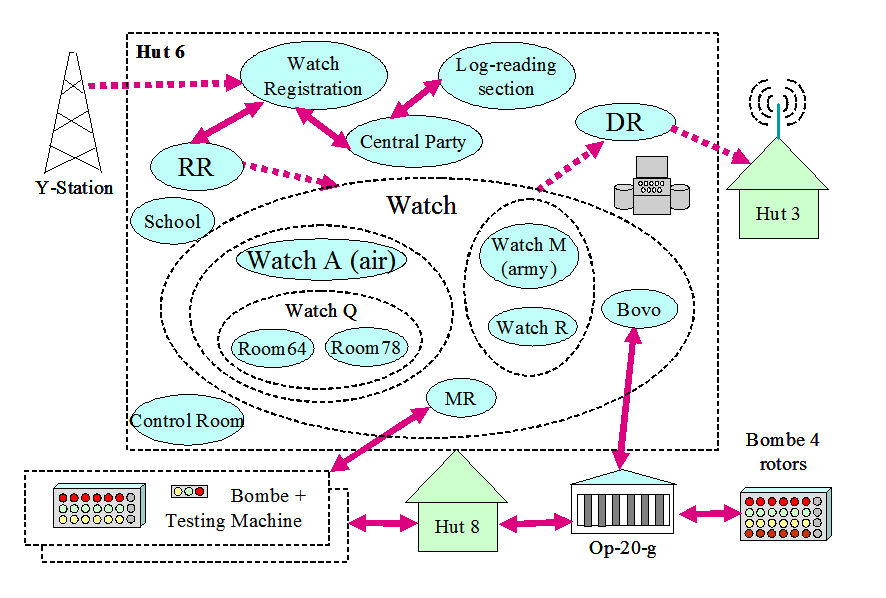Air-Army separation (October 1944-May 1945)

Introduction
The last major change within Hut 6 is the separation of key management for the Army and Air Force.
The war
On the western front, in December 1944, the Germans attempted a last major offensive in the Ardennes. At first, the allies were overwhelmed, but after General Patton's reinforcements, the allies finally won.
In January 1945, the Soviets on the Eastern Front and the Allies (British and American) on the Western Front began to invade Germany.
In May 1945, Germany, after Hitler's suicide surrendered.
The organization
During this period, the Watch is now divided mainly into 2 groups: Watch A (air) and Watch M (army). A third group (Bovo) manages exchanges with the Op-20-g located in the USA and which has very fast 4-rotor bombes (4-rotor bombes can handle 3-rotor problems).
Each watch (air and army) is subdivided into an operational watch and a non-operational watch (generically called "QWatch")
The head of Watch A (air) is responsible for policy on the use of bombes. He is negotiating their use with his counterpart in Hut 8.
The main task of Watch A is to find and to position the Cribs. In the same room as that of the Watch are the members of the Machine Room (MR) who work under the direction of the Watch. The MR actually takes care of the jobs (making menus and managing stops and finding the keys of the day). The MR manages the jobs which are sent to the personnel dealing with the bombes. Then, as before, the keys found are transmitted to the Decoding Room (DR) which decrypts the messages and transmits them to Hut 3.
But Watch A also takes care of the following tasks:
- He monitors the decryption sent to Hut 3 to see if any new Cribs appear.
- It checks for the presence of re-encoding.
- He provides information to the Registration Room (RR) about the structure of radio networks since the abandonment of the kenngruppe.
The Watch Q is made up of:
- Room64, which is responsible for managing the re-encodings which could not be processed quickly as well as those which were detected by the Y Stations (Sixta service).
- Room78 takes care of air keys that are not operational.
Watch R takes care of the non-operational keys of the army.
The Research section is no longer present. Indeed it has disappeared because it fulfilled its role so well, there are no more keys that are completely unbreakable.
Bombes
In May 1945, here are the bombes that were available for Hut 3 and Hut 8:
In England :
- 4 rotors bombes usable only by the Hut 8: 14
- 4 rotor bombes usable by Hut 8 and Hut 6: 54
- 3 rotor bombes usable by Hut 8 and Hut 6: 50
- 3 rotors bombes usable only by Hut 6: 89
- 4 rotor bombes usable by Hut 8 and Hut 6 (Op-20-g): 112
- Electronic 3 rotors Bombe equivalent to 4 bombes: 1
The staff
The Watch is made up of 65 people,
- 24 only for Watch A
- 31 women
- 11 Americans
- Watch A: Monroe and HFT Smith
- Watch Q: Taunt
- Watch M: Nicoll and Read
- Watch R: Aitken and Gaunt
- Bovo: no permanent leader